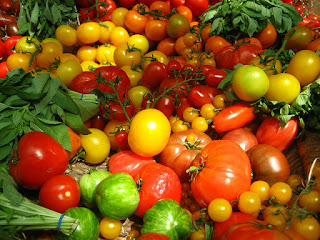It's that time of
year again – beautiful, juicy tomatoes in shades ranging from
orange to purple are appearing on produce
tables and in farmer’s markets. But with all the varieties
available today the tomato aisle has grown more attractive, but it's
also more confusing.
Here are few easy
tips to getting the most nutritious, delicious fruits.
Fruits with a
legacy: heirloom tomatoes. “Heirloom” tomatoes are tomatoes
from lines of seeds that are at least fifty years old. Heirloom
plants aren't genetically modified, and they are open-pollinated by
nature – in other words, by insects and the wind instead of being
hand or machine-pollinated by farmers.
But while tomatoes
labeled as “heirloom” are supposed to be grown in this fashion,
there aren't any regulations governing what is and is not an heirloom
tomato.
I'm not aware of rampant misuse of the term, but grocers
wouldn't even receive a slap on the wrist for mislabeling tomatoes as
heirloom. It's also important to note that heirloom tomatoes aren't
necessarily organically grown.
Getting the best
of two (or more) plants: hybrid tomatoes.
Hybridization is the process of cross-pollinating
two different varieties of a plant to create something new.
Just as you get a “Labradoodle” offspring from poodles and
Labrador retrievers, you can also cross plants to get a single tomato
that combines the desirable traits of each different variety – for
example pest resistance and improved flavor.
Hybridization
is the earliest form of genetic modification, and
farmers have been doing it for over 100 years.
From the lab to
the table: genetically modified tomatoes.
Genetic modification uses laboratories to speed up the process
of hybridization. But instead of just cross-pollinating plants,
scientists have taken things several steps further and now splice
genes from different kinds of produce together.
Whether
you're in the camp that sees GMO foods as progress or you're someone
who thinks of them as “Frankenfoods,” the fact remains that GMO
tomatoes can be higher in nutrients and grow more prolifically in
your garden than heirloom tomatoes.
Keeping it real:
organic tomatoes.
Unlike the “heirloom”
label, “organically grown” means something very specific.
Organically grown tomatoes are NOT genetically modified, (like
heirloom varieties), and
the plants have been grown without synthetic fertilizers and
pesticides.
While I don't think you need to spend the extra money to buy the organic varieties of all of your produce, I do think there are compelling reasons to go organic when it comes to tomatoes. Conventionally-raised tomatoes are 10th on the Environmental Working Group's list of highest pesticide-containing produce – this means that there are actually pesticides underneath the skin of the tomato. No amount of scrubbing that tender skin will get a conventionally-raised tomato clean.
Yes,
most synthetic pesticides are approved for use on food. But we also
used to think that asbestos was safe. Our knowledge of how to grow
the healthiest, safest food is still evolving – so for now, to
avoid ingesting synthetic pesticides, choose organic tomatoes
whenever you can.
**Image courtesy of Jeremy Keith via Flickr
**Image courtesy of Jeremy Keith via Flickr

No comments:
Post a Comment